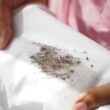Table of Contents Show
Getting to understand your kitchen items and appliances, may not be as easy as many think. For a lot of people, you may have to go through the path of trial and error to fully know what to use and what not to use.
A common kitchen appliance where many make mistakes is the oven. While it may look easy to just put in anything and turn on the heat, putting just anything may cause harm to the oven, the item, your food, or all three.
A very common type of plate in everyone’s home is plastic; you can almost use it for anything. However, can the plastic be used in the oven? If this question is one you have also considered, you should read on, we have some answers for you.
You should never use plastic in the oven, this is because plastic items will begin to soften at very low temperatures and then melt and produce fumes at high temperatures. The plastic will also be releasing chemicals into your food as it melts. It could also catch fire if it stays too long in there.
Although plastic is a well-used kitchen item, especially for keeping food, its use of it in the oven might just be where we draw the line. Plastic may seem suitable for the oven at first, however, when considering what plastic is and what material it is made of, you will have a rethink.
Plastic is a man-made material that is derived from cellulose, crude oil, natural gas, and coal and is produced through the polymerization and condensation processes.
Plastics are organic polymers with a high molecular weight made up of several elements like oxygen, hydrogen, carbon, nitrogen, silicon, and chlorine sulfur. Plastic has recently been made from fossil fuel-based compounds, such as gas and petroleum.

The plastic is then shaped into various products in your kitchen using chemicals and molds.
Based on these materials used in making plastic and the manufacturing process, there are 7 different types of plastic, they are as follows;
- Polyethylene terephthalate (PETE or PET)
- Polyvinyl chloride(PVC)
- High-density polyethylene(HDPE)
- Low-density polyethylene(LDPE)
- Polystyrene or Styrofoam(PS)
- Polypropylene(PP)
- Miscellaneous plastics(acrylic, polycarbonate, polyacrylamide, styrene, acrylonitrile, butadiene, nylon, and fiberglass)
The good news with plastic is that although most plastics are condemned to not be used in the oven, there is an exception. The only type of plastic that can be used in the oven is Crystallized Polyethylene terephthalate (CPETE or CPET).
To withstand heat, this sort of plastic has been crystallized. The CPET is thought to be able to withstand temperatures ranging from 32 to 400 degrees Fahrenheit without melting. This is not to argue that the CPET is completely safe to use in the oven; it is simply more heat resistant than conventional plastic.
If you’re using a CPET, it’s best not to put it in a heat source above 400 degrees Fahrenheit, as this could cause the plastic to melt. When using a CPET oven-able container, it is recommended that you monitor the temperature to ensure that you do not exceed the maximum temperature of 400 degrees Fahrenheit.
Although the CPET is more heat resistant, it is more expensive than a standard plastic container. The CPET may be recycled, is microwave and freezer safe, and is dishwasher safe.
Is Microwavable Plastic Safe In The Oven?
It is quite common to assume that microwavable plastic is safe for oven use; however, this is not true. If a plastic or dish is labeled microwavable, it doesn’t automatically mean it can be used in the oven.
You should not use microwave plastic in the oven; this is because the plastic was designed only for the microwave and not the oven. Placing the plastic in the oven will expose it to high heat for a long period and will result in melting.
There are, however, dishes and containers that are labeled for both microwave and oven, however, they are not made of plastic. They are often Pyrex, stoneware, and ceramic. Ensure you pay attention to the label on your plastic and other containers to know where they can and should be used.
What Temperature Will Plastic Melt?
Telling what temperature a plastic will melt is dependent on the type of plastic that you are using. As plastic-type varies, so also their resistance level to heat varies. i.e., polyvinyl will melt at 175 degrees Fahrenheit, while some other types can withstand some more heat.
However, the average for most types of plastic is between 175 to 300 degrees F.
You must know what type of plastic you have before placing them in the microwave or oven. The only type of plastic that can go as far as 400 degrees F is the CPET.

How To Remove Plastic From The Oven
The best way to remove melted plastic from the oven is to place a bag of ice on top of the melted plastic, this will harden it. Once this is done, you can make use of a tool, such as a razor blade to scrape it off.
Ensure to do it with care so you do not ruin the interior of the oven.
Frequently Asked Questions
Will Gas Melt Plastic?
Yes, gas can melt the plastic. This is why a gas stove oven is not any better for the use of plastic as it can melt it just like the other types of oven.
Can I Use Melamine In An Oven?
No, you cannot and should not use melamine in the oven. This is because melamine is a type of plastic, produced from organic products melamine and formaldehyde, with the use of pressure and heat. Although melamine is considered safe for food according to the FDA, however, it is unsafe for oven and microwave use.
Can I Use Tupperware In The Oven?
No, you should not use Tupperware in an oven. Tupperware is made of plastic and cannot withstand heat for a long period. Tupperware can only stay at a temperature of 80 degrees Celsius; the use of Tupperware in the oven can lead to leaching and melting. Tupperware can, however, be used in a microwave, as long as it is labeled microwave safe.
Final Thoughts
Plastic is one of the most common types of plates in the world; however, the use of plastic is highly prohibited for the oven.
Apart from it melting and damaging the oven, it has the potential to catch fire and ruin more things.
Melted plastic also releases chemicals into the food and this is considered toxic for your consumption. It is recommended that you make use of other types of plates, labeled safe for the oven.













